Karun Chandhok’s Formula 1 car history mixes the sublime and the ridiculous.
His first F1 start came with a team whose car wasn’t ready for the first practice session of the year, never mind pre-season testing.
But since then Chandhok has sampled some of the sport’s most successful cars, including title-winning machines driven by Nigel Mansell, Sebastian Vettel and Lewis Hamilton.
In an exclusive interview for RaceFans, Chandhok shared some of the best stories of his F1 cars.
2010 HRT F110

Having won the Formula V6 Asia series in 2006, joined Red Bull’s Junior Team and tested their F1 car, Chandhok was competing in GP2 and winning races when he got his F1 chance. Four new teams were due to arrive in the sport in 2010, and after speaking to several of them Chandhok eventually signed for Spanish squad HRT.
“I’d been to the US to see Peter Windsor and his people there about US F1,” Chandhok told RaceFans. “I’d been in contact with Tony Fernandes and Mike Gascoyne, so I’d been around the houses talking to different teams.
“Then Bernie [Ecclestone] got in touch and said this deal is happening with the Hispania group and I think we can get something for you there. So he sort of did the deal with Colin Kolles and then the next thing I knew I got a phone call saying, ‘right, you’re in, it’s done’.”But there was a snag – Hispania had taken over an entry which had originally been put together by Adrian Campos. Chassis builder Dallara had paused work on their F110s and the team were racing to finishing construction of the cars in time for the season-opening race in Bahrain.
“When I got to Bahrain, they were literally still building the car. So we never got through the shake down that we were hoping to do in Adria.”
Chandhok’s team mate Bruno Senna was able to drive his car on Friday, but Chandhok’s had persistent engine problems. “I changed in and out of my race suit, I think about eight times between the three practice sessions.”
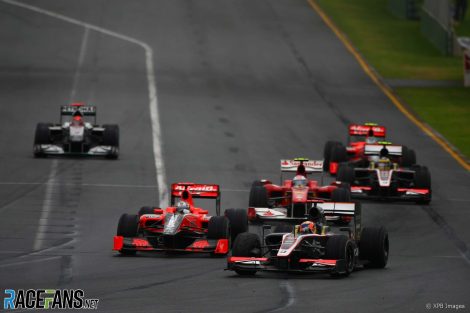
Chandhok qualified last, 10.8 seconds off pole sitter Sebastian Vettel. Senna, 23rd on the grid, was over two-and-a-half seconds slower than the next-quickest car. Nonetheless, with no 107% rule to stop them from racing, the two F110s took the start from the pit lane. Chandhok’s race ended with a spin on lap two.
“The whole Bahrain weekend was so difficult for the mechanics,” he recalls. “I really sympathised for those guys. I think some of them did 56 hours straight working on the car, which is unbelievable.”
To begin with at least the team had high hopes for its car. Aerodynamicist Ben Agathangelou had told Chandhok they would have to race the launch-spec car for the opening rounds outside Europe, but a substantial upgrade was on the way.
Advert | Become a RaceFans supporter and
“[Ben said] ‘It looks like we’re going to have to race this version for the first four races but when we get to Barcelona, here’s the update. This is what we’ve had on CFD and in the wind tunnel, it’s going to be 60 points of downforce, that’s the real car’.
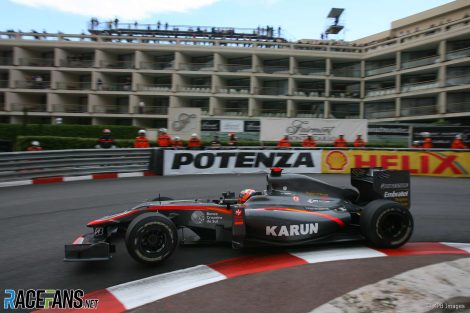
But the promised update didn’t arrive at the Circuit de Catalunya as planned, and the team faced further disappointment at the next race.
“We went to Monaco and that’s when I think things fully fell out between the team and Dallara,” recalls Chandhok. “I don’t fully know the ins and outs of it. All I know is basically that a lot of people from Monaco onwards sort of distanced themselves from us.”
“The Dallara factory was only about three hours away from Monaco and there was a van full of bits of meant to arrived and it never came. So as it turned out that car carried on the entire season in effectively the launch spec.”
This meant running the car in much the same trim at high-downforce Monaco as they did on the long straights of Circuit Gilles Villeneuve. Nonetheless, Chandhok recalls some minor results in the battle among the three new teams that year.
Advert | Become a RaceFans supporter and
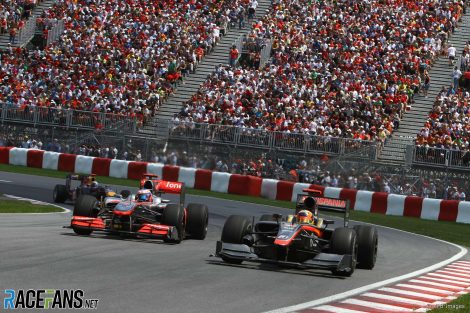
While its shortcomings were obvious – the car only started higher than the back row if another team had a problem – Chandhok remembers the car being surprisingly rewarding to drive.
“It wasn’t actually too unbalanced. We managed to get a vague balance about it. The problem was just the lack of downforce, especially at the front end. We were maxed on the front flap all the time, and that’s wrong obviously.”
“The only weird thing about it was there was at a certain point at a very high speed, for example, if you got to the end of the straight I remember in Shanghai, the wing would get to a stall point and it would start to oscillate. And that obviously upset the balance under braking for the hairpin at the end of the straight. But apart from that, it just like downforce. It was actually quite a drive-able car for the rest of it.”
But Chandhok didn’t get to enjoy the better aspects of the HRT in the second half of the year. For round 10 at Silverstone Sakon Yamamoto appeared in Senna’s place, but thereafter the well-heeled Japanese racer took over Chandhok’s car. However he had impressed enough to earn a place with a rival team the following year.
2011 Lotus T128
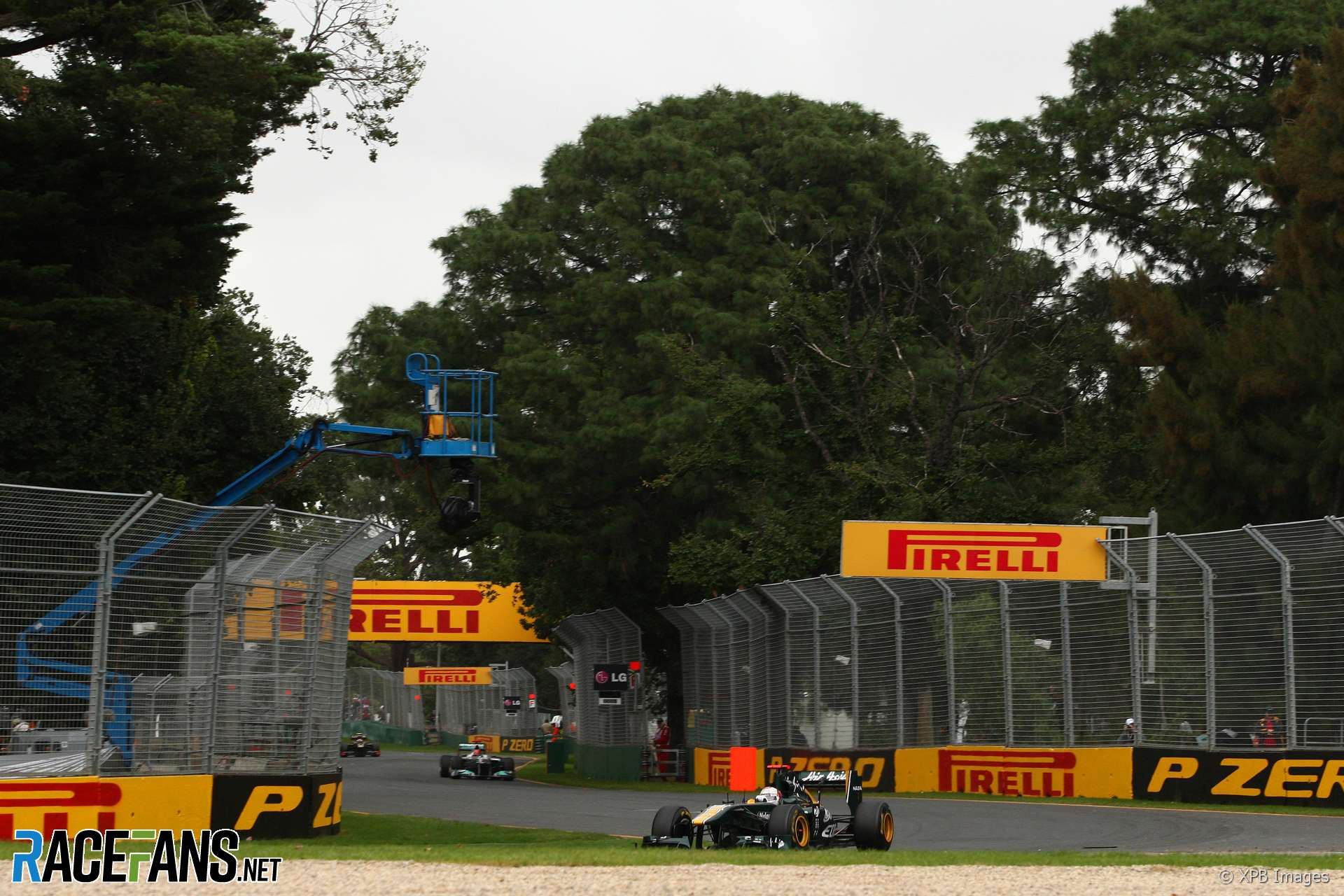
Of the three new teams which made it into F1 in 2010, Lotus established themselves as the most credible, and Chandhok landed a place as their test and reserve driver for 2011. He was also promised a chance to race for the team at his home event – the first-ever Indian Grand Prix on the new Buddh International Circuit.
But things soured quickly. “The whole year wasn’t a fun one for me,” he remembers.
“Being a reserve driver who does a Friday morning, you’re sort of like that cheap spare bottle of champagne at the wedding, which nobody really wants to drink. Nobody really pays enough attention to your opinions. You know, from the Friday morning, you’re just sort of there, they’re just trying to get rid of you and tick the box. I don’t think that’s necessarily the case with every team, but that was certainly the case in that environment. It wasn’t a healthy environment to be in.”
The “internal politics” at Lotus made matters worse, said Chandhok. “Lotus was a small team, but with all of the politics of a big team.
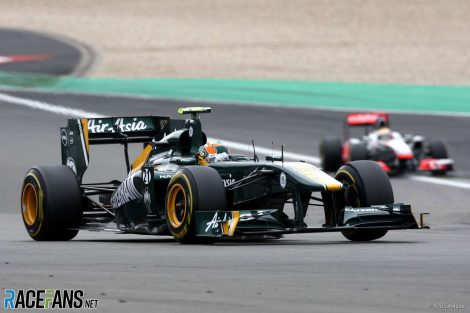
Much was expected of the team’s new T128 chassis after the team agreed deals to switch to Renault engines and use Red Bull’s gearbox. But Chandhok’s first lap in the car during practice for the Australian Grand Prix ended in the wall at turn four.
“It was my first run with the Pirelli tyres and as we know now, in hindsight, they’re very, different to the Bridgestones. I got to turn three and expected grip that wasn’t there and just lit up the rear tyres and went into the wall.
“That put me on the back foot a lot, actually, in terms of a reputation. Not in terms anything in myself because it wasn’t a big shunt, it was a fairly innocuous, knocked the front right corner off, but in terms of reputation internally with the team that set me back I think some way. But that’s life.”
Go ad-free for just £1 per month
>> Find out more and sign up
Chandhok had further practice runs in the T128 which culminated in an unexpectedly early chance to race the car at the Nurburgring. He stood in for Jarno Trulli, who was struggling with the car’s handling.
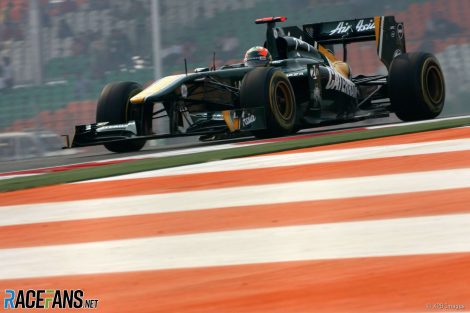
“I did a lot of simulator days, we had a deal with Red Bull to use the simulator so I did a lot of sim days working on the steering system and we came up with a solution which we thought was better, but he still didn’t get on with it.
“Tony got a bit frustrated. At Silverstone as we were walking up the pit lane to go to the grid he said to me ‘I’m going to put you in the car for Germany’. And I sort of went ‘OK, wasn’t expecting that’. I don’t know what it was, a bit of a play between him and Jarno at the time.”
Just 12 days later, Chandhok was practising for his first race in over a year. “Qualifying was okay, I think was just over half a second off Heikki which was not bad. The one thing that caught me out was the brakes, they were very different to anything I’d driven before.”
An overnight change of supplier from Carbone Industrie to Brembos gave him better feel. “That was the first time I could actually relax and drive the car,” he said. Nonetheless he finished a distant 20th in the race.
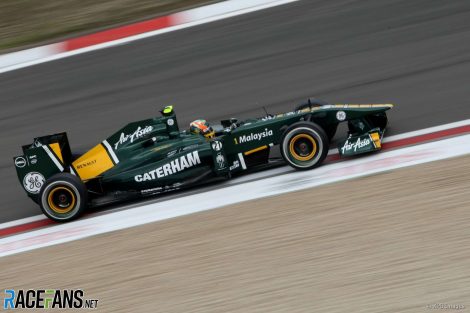
“In Suzuka I remember I drove Heikki’s car. It was my first time at Suzuka and obviously Jarno had been there a billion times before and the only place I lost to him was the entry to turn one the rest of lap I was actually the same if not quicker than him.
“So I was getting there despite no testing mid-season no mileage. And then at that point obviously Tony then reneged on the contract and that was the end of that.”
That was also the end of Chandhok’s time as a racing driver in Formula 1. But many more opportunities to get back behind the wheel lay ahead of him, including a reunion with Red Bull.
2011 Red Bull RB7
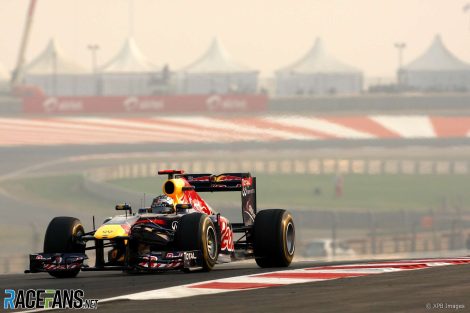
“We went to Kemble Airfield and had a bunch of straight-line testing try and get it to work but at the time I don’t think they could ever really get the blown diffuser working properly. And that was frustrating for the team.”
A few years later he got to experience the system working properly on the car which dominated the 2011 season – Red Bull’s RB7. “It was still the car which had the blown floor and all the rear downforce,” he recalls.
The car felt vastly different to the Lotus he once raced against it. “Obviously we were on demo tyres but I got to do a few good laps of Paul Ricard. There was no mileage restriction because the cars were so out of date.
“It was a really enjoyable experience and it was the most nimble, agile race car I’ve ever driven. It had so much rear downforce and so much stability on the way in.
“I’m sure we didn’t have the peak blown diffuser maps that they would have had when racing in period but it was still working because that’s the design of the car and the Renault engine still had the blown engine over-run maps in it. And it was just cool to experience what was a great car from that era was because they were so dominant.”
1992 Williams FW14B
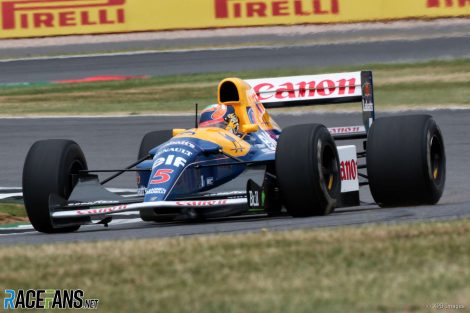
“I think the most emotional experience was driving Mansell’s FW14B from ’92,” he says. “For anyone who was born in the eighties, that era of Formula 1, Senna versus Mansell versus Prost, that was what we grew up watching.
“To be able to drive red five on British Grand Prix Sunday morning and Saturday after qualifying in front of a whole crowd that was very special and very cool.”
Chandhok has also driven the FW14B’s similarly high-tech successor, the FW15C, and finds it remarkable how sophisticated the cars were given the comparatively rudimentary computing power available at the time.
“The cars were so far ahead of [their] time,” he says. “It was when the world was transitioning from DOS to Windows and using that they wrote the software for active suspension, traction control, blown diffuser, launch control, all of this software. And then in ’93 it had individual pot braking to effectively give the car brake-steer.
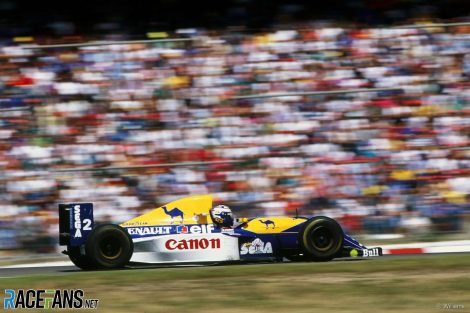
While later versions of the car used chunky one-megabyte memory sticks, an early test car used an onboard printer to collect data.
“Paddy said to me the first version had this sort of ream of paper in the sidepod of the 13B, the 1990 car, which they used as a test hack. And the data was being written on this ream of paper. So if the car broke down on track, the people would still be churning out with the data being written and they had to sort of scroll it back to find it.”
Go ad-free for just £1 per month
>> Find out more and sign up
2004 Williams FW26
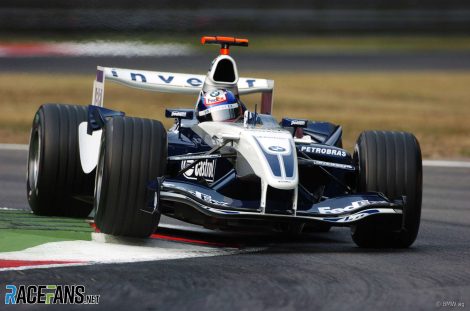
“The engineers from BMW showed me the data,” says Chandhok. “In true German fashion, they still had all the dyno sheets from that engine that was in that particular chassis I drove and it was 952 horsepower. Bearing in mind it’s 605 kilos, that’s a better power-to-weight than a current car and with much less downforce, obviously.”
The performance of the FW16 made a huge impression on Chandhok. “That car, at every corner it scared me. I was in awe of it. It was like, holy cow, this is a sensory overload like I’ve never experienced.
“And of course, you got the sound of 19,000rpm. They only took about five or six hundred rpm off the top when I drove the car recently so it still had plenty of grunt and plenty of revs. So to me that was probably the most awe-inspiring experience of driving a racecar.”
2019 Mercedes W10
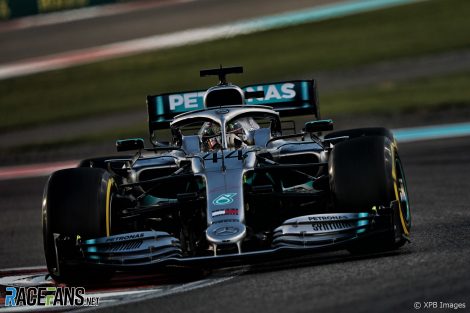
Chandhok drove the W10 which took Hamilton to his sixth world title last year and described it as “the most perfect race car I’ve ever driven.”
“There was nothing to fault in it. There’s no balance issues, everything just worked. They had a solution for everything. If there was an imbalance, you could tweak a switch on the steering wheel, you had engine braking support, the diff settings, the maps were all perfectly made up. The brake balance maps were a perfectly made up.
“The baseline was great but then you had a solution which you could tweak in the cockpit if you had any small issues. And that made it such a perfect race car. I think in some ways it’s taken away some of the challenge of what F1 should be and F1 was, I think in that early 2000s era.”
But while he feels today’s cars are heavier and in some respects less demanding than their predecessors, Chandhok is wary of looking back on past eras with too much affection.
“I think the reality is that the world has changed a lot from the early nineties, hasn’t it? People look at the past with rose-tinted glasses, and I’m guilty of that as well.
“I watched the ’86 Australian Grand Prix that was on YouTube a couple of days ago. And everyone looks at that era being amazing and the spectacle of it.
“But in reality, even up to the early nineties, you’d often have only three or four cars and the lead lap and the racing was actually sometimes pretty rubbish, really. Prost and Senna would disappear off and finish a lap ahead of the rest of the field in ’88 or ’89. That would not be tolerated today.”
Video: My F1 Cars – Karun Chandhok
Watch an extended version of this interview with much more insight from Chandhok on the RaceFans YouTube channel:
Become a RaceFans Supporter
My F1 Cars is part of a new series of articles we are running throughout the hiatus. To help RaceFans produce more great original content – and to browse the site ad-free – please consider becoming a RaceFans Supporter.
Find out more and sign up here:
Go ad-free for just £1 per month
>> Find out more and sign up
F1 history
- How you rated F1’s 12 sprint races so far – and why two outscored the grand prix
- Alonso set to become F1’s oldest driver for more than 50 years
- From ‘Flying Pig’ to Senna’s heroics: The short, incredible history of Toleman
- From farcical to fantastic: Formula 1’s 14 title-deciding Japanese races ranked
- Benched: The five other drivers who stood down for team mates in last 50 years




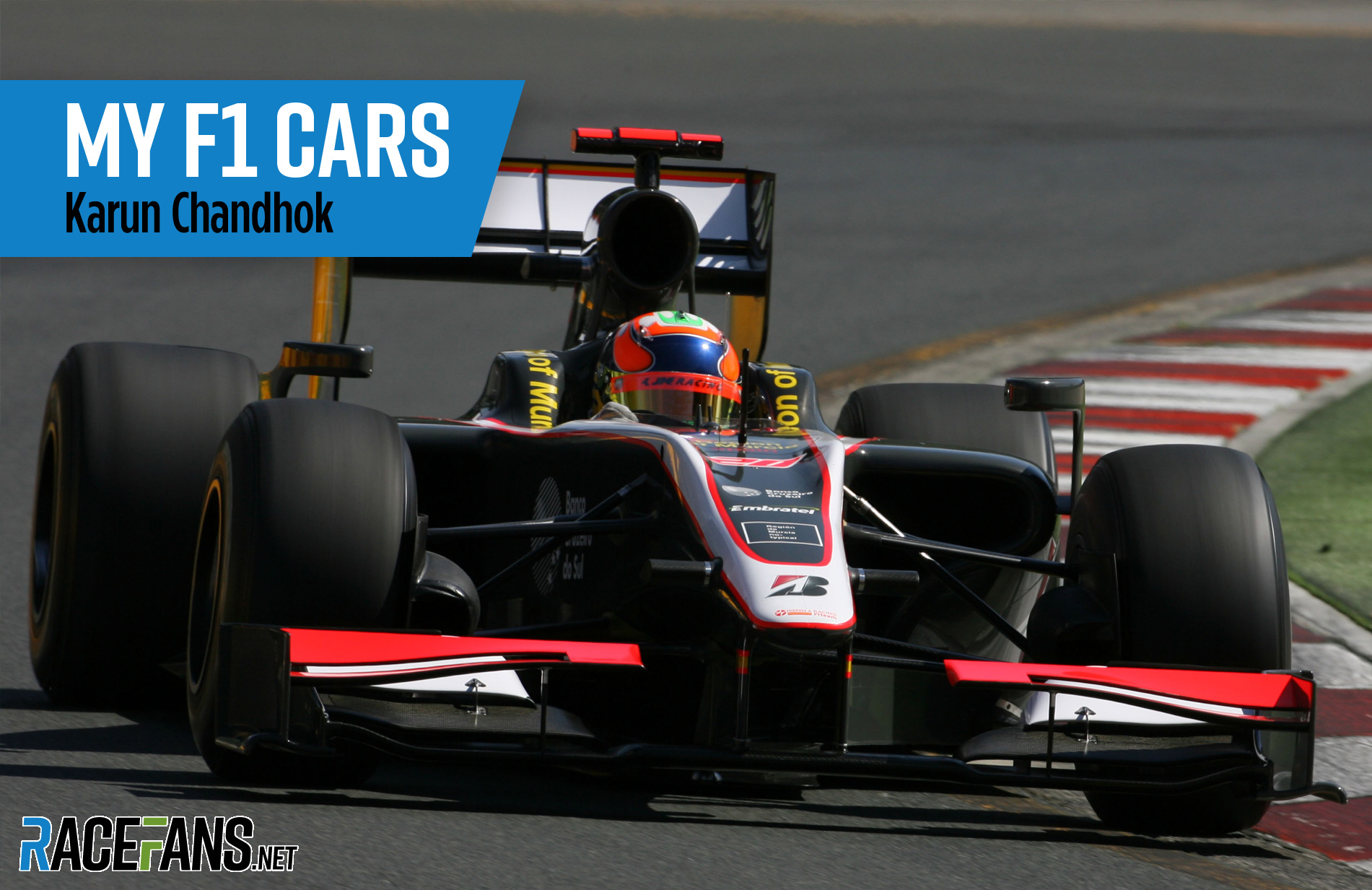
Stephen Higgins
10th April 2020, 13:13
Karun has always struck me as a very intelligent chap indeed.
Deserved a crack in an upper midfield car at least.
Chris
10th April 2020, 18:32
He’s an outstanding commentator and analyst.
Ben Rowe (@thegianthogweed)
10th April 2020, 20:21
Yea whenever I heard him and Ben Edwards commentating for practice sessions when Channel 4 had live stuff, his knowledge was very apparent. And at least Ben Edwards does take part in some current racing series of sorts. They both sound very knowledgeable and passionate about the sport. I hate listening to Crofty who really sound like he very much lacks knowledge as well as interest. He constantly steers off topic, especially in practice sessions. On Sky, I think Chandhok and Di resta would be a good line up. Anyone to replace Crofty basically would still make it better though.
Sensord4notbeingafanboi (@peartree)
10th April 2020, 23:13
I think he was pretty decent. I think he fared better than Senna, something to be proud of.
Fer no.65 (@fer-no65)
10th April 2020, 13:49
I don’t care if it’s rose tinted glasses, nostalgia, my 30th birthday or whatever … I want the late 90s back. Even the early 2000s.
And that intro before races with the guitar solo. I could listen that for days.
Fer no.65 (@fer-no65)
10th April 2020, 13:51
Btw I’m loving this series. I’ve always been interested in the bad cars on the grid, the rejects… Thats why this, or the beyond the grid podcast, is so good. Knowing what they had, how it worked (or not) and what their plans were is fascinating.
Keith Collantine (@keithcollantine)
10th April 2020, 15:15
@fer-no65 Thanks very much! We’ve got a couple more of these recorded and have more planned for the coming weeks.
Fer no.65 (@fer-no65)
10th April 2020, 16:27
@keithcollantine Looking forward to it! Hope you get to talk with someone from the Virgin team back then, about the CFD only car, and the small fuel tank.
mmertens (@mmertens)
10th April 2020, 18:54
Yes! Is amazing to have insights from drivers from these rejects ! I wonder if you could do the same with Roberto Moreno? He drove awful cars and also great ones as well!!! Great series Keith
ferrox glideh (@ferrox-glideh)
10th April 2020, 14:50
That intro before the races with the guitar solo is the second half of the song “The Chain” by Fleetwood Mac, and every time I hear it Murray Walker says something amusing in my head :)
Fer no.65 (@fer-no65)
10th April 2020, 16:24
@ferrox-glideh no, not that one, this one: https://www.youtube.com/watch?v=qgiBkydMW8k
anon
10th April 2020, 15:02
@fer-no65 the thing is, the 1990s and 2000s weren’t always positive – the team bankruptcies and political fighting that went on in that era means there were some fairly hefty downsides in that era as well.
Sensord4notbeingafanboi (@peartree)
10th April 2020, 23:28
F1 was much less deterministic, in the past.
I say history because it happened in the past.
Bexause aything happens in Grand Prix racing, and it usually does.
Now seriously, if the race was bad the championship was good and you never knew if the cars were going to last or even the drivers. Overtakes were possible. The downsides are the same but manifest in different ways. Back then the engines even simpler made a huge difference also running Pirellis back then was for backmarkers.
Duncan Snowden
11th April 2020, 12:08
Oh, no. Not the refuelling era, when the race was over two-thirds of the way through. (While writing this comment, which I’ve chopped and changed a lot over the last half-hour or so, I found this. Sure, overtaking is “artificial” these days with DRS, but look how rare it was in the early 2000s, and how much it improved in 2010, the year refuelling was banned, and before DRS was introduced.)
I think I’ve said this before, but in the 30-odd years I’ve been following F1 I can’t remember a time when people weren’t going on about how much better it was 20 years ago. It used to be said of Punch magazine that it wasn’t as funny as it used to be, “but then it never was”. The same might be said of F1’s excitement. You also have to go pretty far back to recall a time when someone wasn’t complaining about overtaking; I remember arguments about the relative merits of IndyCar and F1 on those terms during Mansell’s time in America. Which isn’t to say those complaints are wrong, exactly – it may, arguably, be even worse now than it was in the ’90s (in technical aerodynamic terms it almost certainly is; as for the actual racing, I’m not so sure) – but the point is that F1 hasn’t been a paragon of close wheel-to-wheel battling for a very long time, and people have been calling it “boring” for literally decades.
anon
12th April 2020, 9:30
Duncan Snowden, when F1 tried to strike a commercial deal with the UK’s ITV network in 1971, they rejected it and published a response stating they were not interested as “it would make for poor viewing for the average spectator, as more often than not, the race descends into a procession with very little overtaking”.
That is about 50 years ago now, and yet even in what was supposed to be a golden era, people complained the races were processional and lacked action.
Jose Lopes da Silva
10th April 2020, 15:39
I can’t understand why people complain about 2016 and praise 1988.
Great article! More of it, please.
JJ (@jjfrazz)
10th April 2020, 17:56
DOS to Windows: 1985. It was wind tunnels that changed the game for the super rich teams.
anon
10th April 2020, 23:58
@jjfrazz that isn’t really the case, because wind tunnel testing was already being practised in the sport in the 1950s, and was already driving aerodynamic decisions.
Mercedes was conducting wind tunnel testing at the Stuttgart Technical Institute in the 1950s, resulting in the streamlined versions of the W196 – don’t forget that Mercedes had already been carrying out wind tunnel testing back in the late 1930s for their land speed record cars, and the wind tunnel itself is a 19th Century invention.
Part of the incentive for Cooper Cars to switch to mid-engined cars in the late 1950s was driven by aerodynamics and the fact they could minimise the frontal area – Cooper had a pretty good relationship with the Transport and Road Research Laboratory, enabling it to use the facility (technically breaking the rules, as it was not meant to be used for motorsport).
Forghieri also records Ferrari as having signed a deal to use the Stuttgart Technical Institute’s wind tunnel in the early 1960s, and by the late 1960s Imperial College was renting out their wind tunnel – there are shots of the BRM P142 from 1969 that you can find (what could have been the first “ground effect” F1 car, in the sense of having a sculpted underbody, if Surtees hadn’t killed the project).
By the early 1970s, wind tunnel testing was somewhat routine – Fittipaldi partnered with Embraer to use their wind tunnel in 1973 and 1974 when developing the prototype FD01, for example.
What changed was that, in 1975, Tony Southgate took advantage of being able to use a proper rolling road wind tunnel when Imperial College upgraded their wind tunnel to have a true rolling road, rather than a static surface. It was the real reason why the Shadow DN5 was so quick in 1975 – they were the first to cotton on that static tests resulted in a centre of pressure that was further forward than on a rolling road tunnel, so most teams were underestimating the amount of downforce that the front wings were actually producing and giving the cars major understeer as a result.
The thing is, Shadow was not a particularly rich or large team at the time – they just happened to be well connected with one of the few facilities in the UK that had a true reasonably large scale rolling road wind tunnel that they could rent. By the 1970s, even a team that was only moderately large still had reasonably good access to a wind tunnel – the idea that, as a piece of technology, wind tunnel were somehow a recent addition that transformed the sport isn’t really true, as it’s really been there from the beginning.
As an aside, the use of a physical printer in the FW14 in 1992 to print out the data sounds a bit behind the development curve for that era. Fittipaldi were using that level of technology in the 1970s, and in the late 1970s Tyrrell already had electronic onboard storage that allowed then to save data to storage units onboard the car to download at a later date.
By the late 1980s, car to pit wall telemetry was available in at least “burst” format – i.e. short bursts of data that could be transmitted back to the pits as the car passed the pit wall. I’m surprised that Williams, given they were meant to be one of the more advanced teams in the sport at the time, was still using technology that sounds closer in some ways to what was being done at least 15 years earlier.
KaIIe (@kaiie)
10th April 2020, 20:37
What, a car with printer attached to it? I wonder if there are any photos of this test mule, sounds extremely interesting.
Sensord4notbeingafanboi (@peartree)
11th April 2020, 6:07
@kaiie That car was a Canon.
Frasier (@frasier)
11th April 2020, 11:22
Fascinating article. Always liked Karun, a very good communicator and it shows in this piece. Pleased that he didn’t pull his punches when praising or criticising.
John Richards (@legardforpresident)
11th April 2020, 13:15
@keithcollantine I hardly comment on here, Mr. Collantine. But I had to log in to tell you that this was a very thought-provoking article indeed!
Would also like to add to Karun’s point; If I remember correctly, didn’t Adrian Newey say that the RB6 (2010) was the fastest car he’d ever seen. He was quoted as saying, “[the RB6 was] probably the car with the most downforce in the history of F1”
GeeMac (@geemac)
14th April 2020, 13:49
This is why I listen to everything Karun has to say. He’s a properly clever guy who gets what racing is all about. As much as we look to the past with rose tinted specs, if you actually watch races from that era they can be painful compared to what we have today. We are very lucky…
gruppeb86
18th April 2020, 10:40
I agree rgarding final 4 paragraphs and those who have commented to back-up Karun. My main problem with the cars today is reliability. I understand why we are where we are, but unlike times gone by, there are far fewer mechanical surprises.
Great reply by @kaiie “That car was a Canon.” We could do with a like and dislike function.